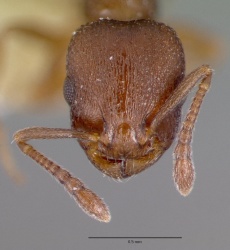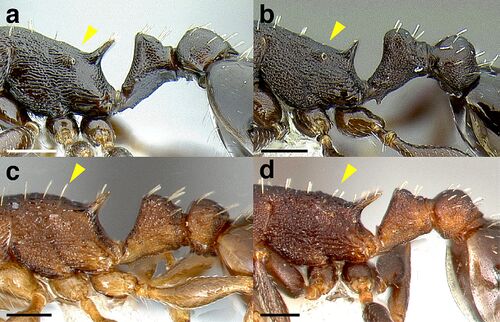Key to New World Temnothorax clades
This worker key is based on: Prebus, M.M. 2021. Taxonomic revision of the Temnothorax salvini clade (Hymenoptera: Formicidae), with a key to the clades of New World Temnothorax. PeerJ. 9:e11514 462p. doi:10.7717/peerj.11514.
You may also be interested in
1
- Antennae with 11 segments . . . . . 2
- Antennae with 12 segments . . . . . 7
2
return to couplet #1
- Postpetiole broad and campaniform in dorsal view; mesosoma strongly arched and bearing long propodeal spines; Cuba . . . . . Temnothorax cuyaguateje (incertae sedis in Temnothorax)
- Not matching the above description; broadly distributed . . . . . 3
3
Return to couplet #2
- Antennal scrobes present (Fig. 18A); masticatory margin of mandible with four teeth; eastern North America . . . . . Temnothorax americanus (Palearctic clade, part)
- Antennal scrobes absent (Fig. 18B); masticatory margin of mandible with five teeth; broadly distributed . . . . . 4
4
return to couplet #3
- Propodeal spines reduced to small, rounded angles (Fig. 19); petiole acutely cuneiform in profile; arboreal species known only from west central California . . . . . Temnothorax oxynodis (andrei clade, part)
 Figure 19. Temnothorax oxynodis |
- Propodeal spines variable; petiole in profile shaped otherwise; broadly distributed . . . . . 5
5
return to couplet #4
- Petiole compact and node evenly rounded in profile (Figs. 20A –20E) and laterodorsal surfaces of head directly behind compound eyes smooth and shining (Figs. 20K–20O); postpetiole often with an anterior bulge in profile view (except T. mmp 15 from Puerto Rico; see Prebus (2017) and antweb.org) (Figs. 20A–20E); arboreal species of the American Southwest through Central America and Greater Antilles . . . . . obturator clade, part
- If petiole is rounded (some species in the rugatulus clade, Figs. 20G & 20H) then laterodorsal surfaces of head directly behind compound eyes sculptured (Figs. 20P–20T) (sculpture light in T. schaumii (Roger), Fig. 20R); postpetiole often without an anterior bulge in profile view (except some specimens of T. schaumii) (Figs. 20F–20J); broadly distributed . . . . . 6
6
return to couplet #5
- Antennal scapes long, separated from the posterior margin of head by about 1x maximum width of the antennal scape or less when fully retracted: SI> 80 (see Fig. 21A for diagram, Figs. 21B –21D for examples); if unclear (some specimens of T. ambiguus) then head sculpture areolate-rugulose, without overlying strong costae (but may be costulate) (Fig. 21B); North America, east of the continental divide . . . . . longispinosus group (Palearctic clade, part)
- Antennal scapes short, separated from the posterior margin of head by>1x maximum width of the antennal scape when fully retracted: SI <80 (see Fig. 21E for diagram, Figs. 21F–21H for examples); if unclear (some specimens of T. rugatulus (Emery)) then head sculpture rugulose, with overlying strong costae (Fig. 21E); widespread . . . . . rugatulus clade
7
return to couplet #1
- Matching the following description: head, mesosoma, and waist segments areolate and propodeal spines reduced to small teeth or angles and petiolar peduncle short (Figs. 22A–22D) and postpetiole moderately broad: PWI 140–160; southern United States and Northern Mexico . . . . . andersoni clade
- Not matching the above description; if head, mesosoma, and waist segments areolate, then propodeal spines more developed and petiolar peduncle longer (Figs. 22E–22H) and postpetiole broader; widespread . . . . . 8
8
return to couplet #7
- Postpetiole narrow, less than 1.5 times the maximum width of the petiolar caudal cylinder (PEW) in dorsal view: PWI <150 (Figs. 23A–23F); if PWI is 150–155, then antennal scapes short, when fully retracted, failing to reach the posterior margin of the head by about two times the maximum width of the antennal scape: SI <80 (Figs. 24A–24C); NOTE: PWI is not always obvious at first glance: careful measurements should be taken; PEW in this article is measured across the caudal cylinder of the petiole . . . . . 9
9
return to couplet #8
- Antennal scapes short: when fully retracted, failing to reach the posterior margin of the head by about two times the maximum width of the antennal scape: SI <80 (Figs. 24A–24C); petiolar node evenly rounded in profile; caudal cylinder of petiole generally elongate (Figs. 24D–24F); arboreal species from the American southwest through Central America and Greater Antilles . . . . . obturator clade
- Petiolar node shaped otherwise; if petiolar node is rounded, then antennal scapes long: SI> 80; arboreal or not; broadly distributed . . . . . 10
- Postpetiole broad, greater than 1.5 times the maximum width of the petiolar caudal cylinder in dorsal view: PWI> 150 (Figs. 23G–23L); if PWI is 150–155, then antennal scapes longer: SI> 80 . . . . . 14
10
return to couplet #9
- Propodeum without erect setae dorsally, but a single pair may arise from the metanotal groove (Figs. 25A & 25B); Chiapas, Mexico . . . . . salvini clade
- Propodeum with at least one pair of erect setae dorsally (Figs. 25C & 25D); North America, west of the Great Plains . . . . . 11
11
return to couplet #10
- Petiolar node not cuneiform (Figs. 26A–26D) . . . . . andrei clade, part
- Petiolar node cuneiform (Figs. 26E–26H) . . . . . 12
12
return to couplet #11
- Anterior face of petiolar node straight, not concave in profile view (Figs. 27A & 27B); if unclear, posterior margin of head with ten or more erect setae and medial lobe clypeus with three distinct carinae (Fig. 27C) . . . . . sallei clade, part
- Anterior of petiolar node concave in profile view (Figs. 27D & 27E); if unclear, posterior of head with 8 or fewer erect setae and medial lobe of clypeus without three distinct carinae (Fig. 27F) . . . . . 13
13
return to couplet #12
- Medial lobe of clypeus convex anteriorly and bearing three distinct carinae (Fig. 28A); North America, Rocky Mountains . . . . . Temnothorax furunculus (Palearctic clade, part)
- Medial lobe of clypeus flat to emarginate anteriorly and not bearing three distinct carinae (several to many indistinct, but median carina not distinct along the majority of the median clypeal lobe; Figs. 28B & 28C); North America, west of the Great Plains . . . . . andrei clade, part
14
return to couplet #8
- Petiole without tubercles united by a distinct carina anterodorsally: profile of dorsal surface of petiole, when viewed from a ventrolateral angle, not interrupted by a tubercle anteriorly (Fig. 29A); or, if present, postpetiole is broadly attached to anterior margin of gaster (Fig. 29B) . . . . . 15
- Petiole with tubercles united by a distinct carina anterodorsally: profile of dorsal surface of petiole, when viewed from a ventrolateral angle, interrupted by a tubercle anteriorly (Fig. 29C); postpetiole not broadly attached to anterior margin of gaster (Fig. 29D) . . . . . 19
15
return to couplet #14
- Dorsum of mesosoma evenly convex in profile; dorsum of propodeum rounding evenly into the propodeal declivity; propodeum either entirely without teeth or spines (Figs. 30A–30C) or with small teeth, in which case the teeth do not mark an angulate transition between the dorsum and declivity of the propodeum (Fig. 30D); Central America, Cuba, and Puerto Rico . . . . . sallei clade, part
- Dorsum of mesosoma in profile variable: evenly convex or not; propodeum bearing teeth or spines or, if uncertain, transition from dorsum to declivity of propodeum is marked by an angle, not rounded as above; broadly distributed . . . . . 16
16
return to couplet #15
- Matching the following description: propodeal teeth reduced, or transition from dorsum to declivity of propodeum is marked by an angle (Figs. 31A & 31B); legs moderately incrassate (FI <300), and without abundant erect to suberect setae (Figs. 31C & 31D); petiolar node evenly rounded in profile (Figs. 31A & 31B); mid to high elevations, from central Mexico to the Nicaraguan depression . . . . . sallei clade, part
- Not matching the above description; broadly distributed . . . . . 17
17
return to couplet #16
- Matching the following description: clypeus forming wall between antennal insertions and mandibles (Figs. 32A–32C); anterior margin of clypeus flat; posterior margin of head rounding evenly into lateral margins; legs not incrassate (Figs. 32G–32I); southwestern United States and northwestern Mexico . . . . . sallei clade, part
- Not matching the above description. If specimen is from southwestern United States and northwestern Mexico and the clypeal character is unclear, then the anterior margin of clypeus emarginated, posterior margin of head transitions to lateral margins through a rounded angle (Figs. 32D–32F), and legs strongly incrassate (Figs. 32J–32L); broadly distributed . . . . . 18
18
return to couplet #17
- Postpetiole campaniform in dorsal view (Fig. 33A); legs with abundant suberect to erect setae (Fig. 33B); if petiole squamiform and increasing in width toward the apex (Fig. 33A), medial lobe of clypeus with 3 or fewer distinct carinae (Figs. 33C & 33D); southern Florida, Bahamas, Cuba, Hispaniola . . . . . sallei clade, part
- Postpetiole variable; legs usually without abundant suberect to erect setae; if present (Fig. 33F) and petiolar node squamiform and increasing in width toward the apex (Fig. 33E) then medial lobe of clypeus with many fine carinae (Fig. 33G) or propodeum is strongly depressed (Fig. 33H); broadly distributed
19
return to couplet #14
- Postpetiole with a distinctive trapezoidal shape in dorsal view: anteriorly broad, with angulate anterolateral corners (Fig. 34A); southwestern North America . . . . . Temnothorax quasimodo (andrei clade, part)
- Postpetiole in dorsal view not as above (Figs. 34B–34D); broadly distributed . . . . . 20
20
return to couplet #19
- Medial lobe of clypeus smooth medially or bearing three distinct carinae, although these may be accompanied by additional weaker, incomplete carinae (Figs. 35A–35C) . . . . . sallei clade, part
- Medial lobe of clypeus bearing many fine carinae (Figs. 35D–35F), although these may be in addition to the three strong carinae (Fig. 35F) . . . . . 21
21
return to couplet #20
- Metafemora incrassate: FI> 325 (Fig. 36A; see couplet #10); or, if not incrassate, erect setae absent from the propodeal dorsum (Figs. 25A & 25B) . . . . . salvini clade, part
- Metafemora not incrassate FI <325 (Fig. 36B); erect setae always present on the propodeal dorsum (Figs. 25C & 25D) . . . . . sallei clade, part





















